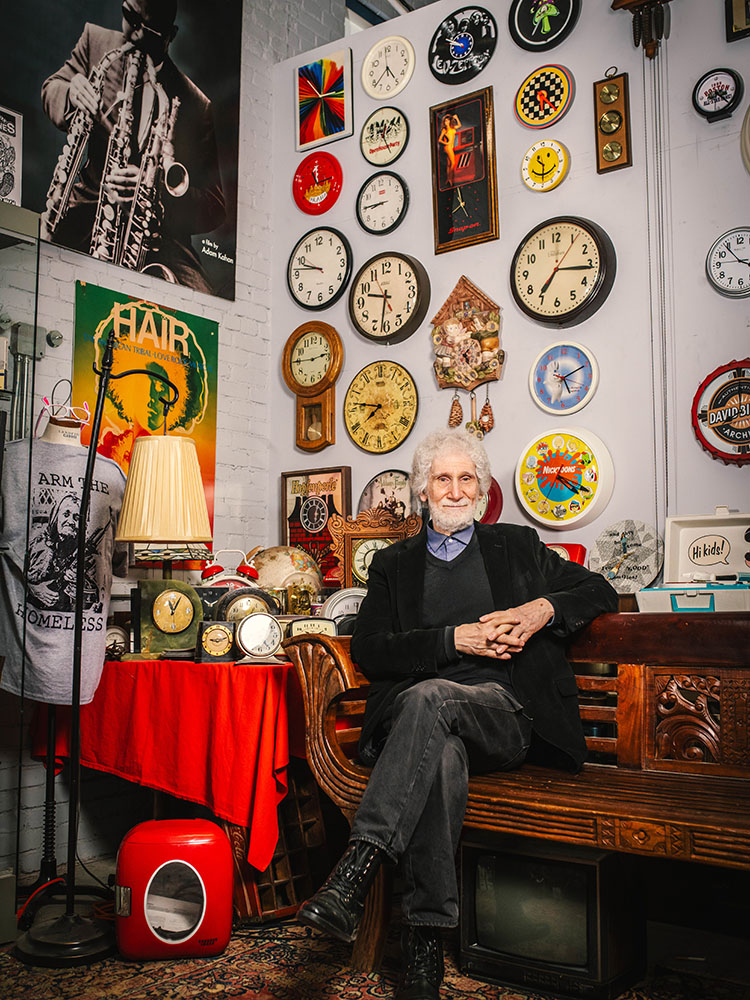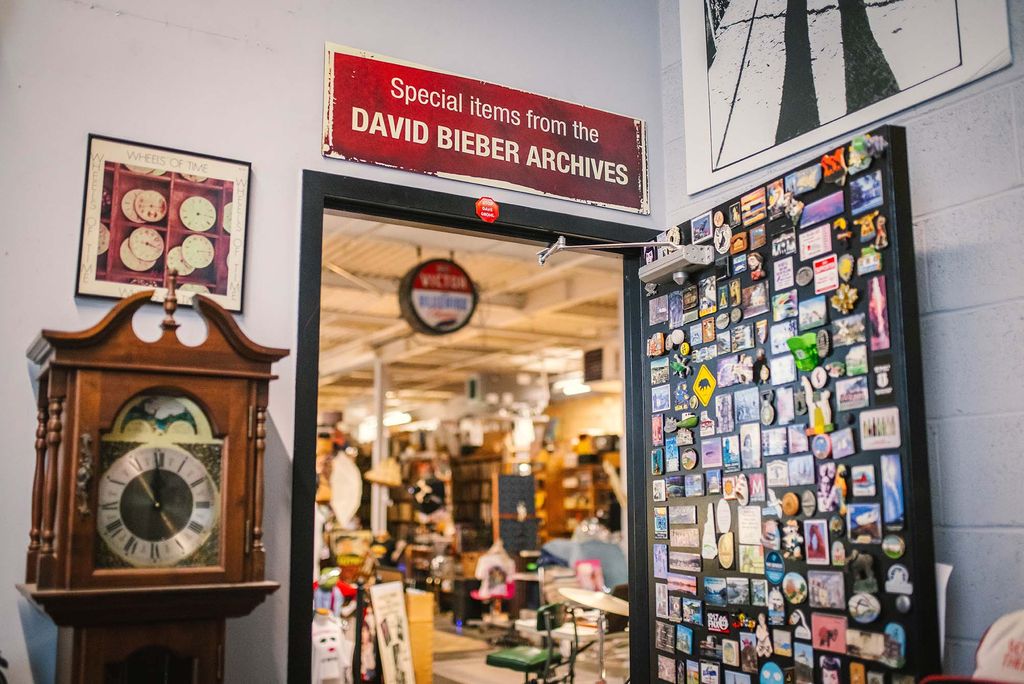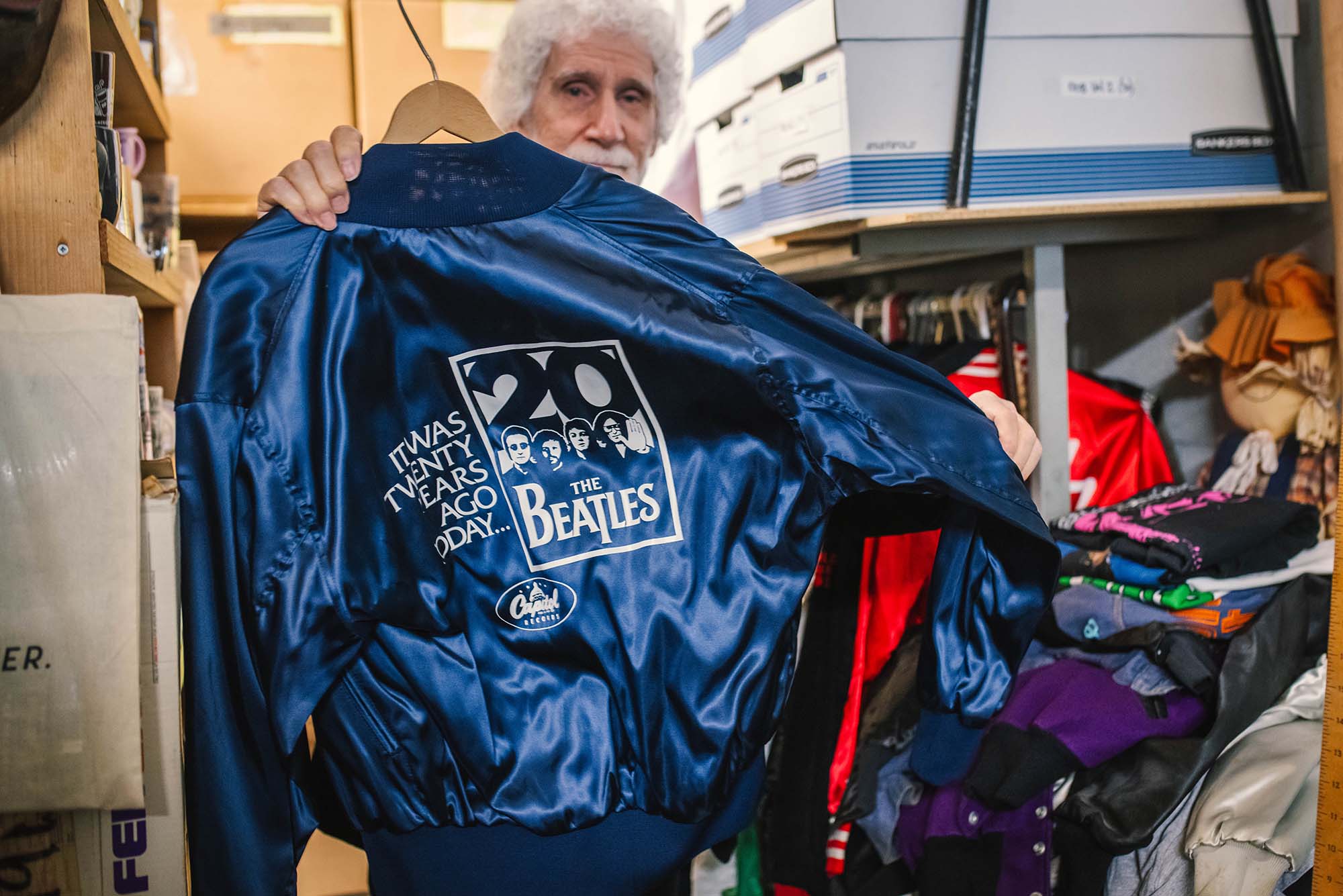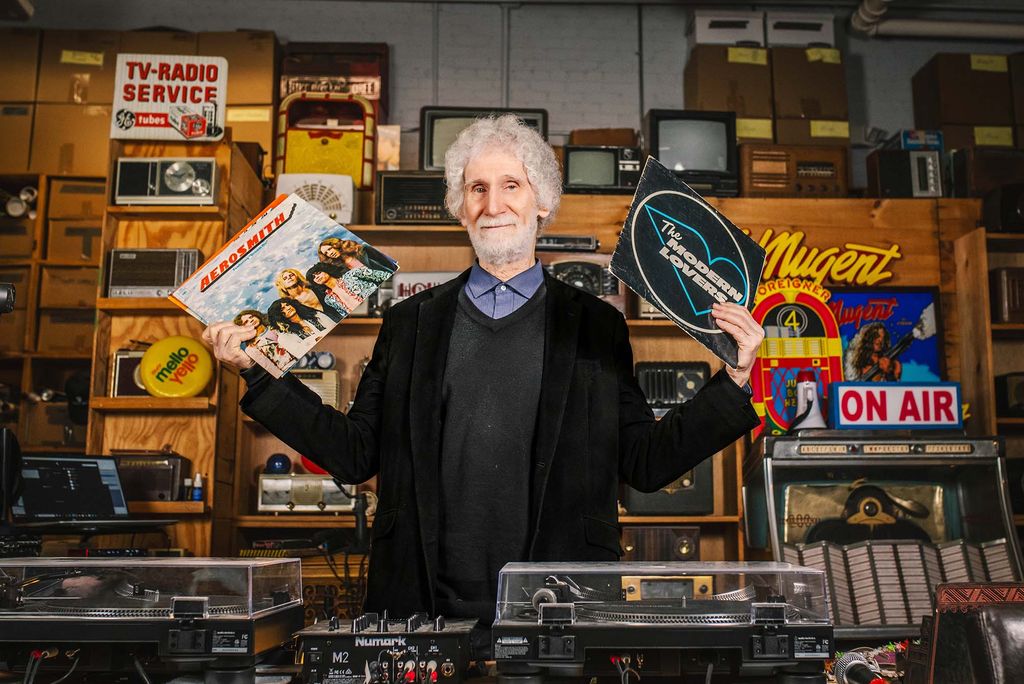Pop Culture Archive Features Memorabilia, Nostalgic Artifacts

David Bieber (COM’70) began collecting regional soda pop bottle caps as a kid, then came stamps, baseball cards, and MAD magazines. Now, he stores his massive collection in a Norwood, Mass., warehouse.
One Man’s Treasure
Alum David Bieber, a presence on the Boston music and media scenes for decades, has built a collection of more than two million pop culture artifacts, from LPs and CDs to radios and TVs to T-shirts, badges, and political buttons
Ask any other Boston University alum how college impacted their life and you probably won’t get the answer David Bieber gives.
“First and foremost,” Bieber says, “I’m alive today because of BU. Because otherwise, I would have been drafted and shipped to Vietnam and be dead.”
His mood is both reflective and matter-of-fact. We both half-chortle, the way you do when looking back at something that could’ve taken a tragic turn, but didn’t.
“That was a point when student deferment was still looming large,” says Bieber (COM’70), “and I was able to segue from my bachelor’s degree at Kent State in Ohio to BU, where I got my master’s in journalism.”
Bieber’s 160-page thesis—about how the underground media impacted the traditional media in a transitional period—caught the attention of WBUR-FM’s assistant general manager, Clark Smidt, who hired him to be music director at the station. Back then, WBUR featured dayparted block programming, such as rock, classical, and Indian music, controversial comedy, and live performance. Bieber did a two-hour interview with David Bowie live in the studio on his first US promotional tour in 1971.
And with that, Bieber, who’d freelanced for Billboard, the Boston Globe, Fusion, and Boston’s competing underground weeklies—the Cambridge Phoenix and Boston After Dark—joined the ranks of fully employed media professionals.
Bieber built his collection, which includes T-shirts and posters, in different ways, sometimes showing up early in the morning at flea markets and yard sales.
Bieber, who stands six foot one and remains, as he puts it, “at my high school fighting weight of 145,” is in his late 70s. He has been a prominent presence—sometimes behind the scenes, sometimes in front—on the Boston music and media scenes for more than four decades. He was the creative services director for rock powerhouse WBCN-FM for 16 years, through 1994. Then, he was hired by Stephen Mindich (CFA’65, COM’67), owner of Phoenix Media Group, to be director of special projects for the long-running alternative weekly paper, the Boston Phoenix, and WFNX-FM, a challenger to ’BCN—in hip cachet and alt-rock credibility, if not ratings. That lasted 19 years.
Mindich shuttered ’FNX in July 2012 and then, eight months later, abruptly folded the Phoenix tent. And so in March 2013, Bieber, without a day job, didn’t quite know what he’d do for a third act.
“I had the luxury of not being frantic,” he says. “I knew something would happen, but I didn’t know what.”
What he did know is this: about a quarter century earlier, he had rented massive space in a warehouse in Avon, Mass., and stuffed it with boxes upon boxes filled with the spoils of collecting pop culture artifacts, a lifelong obsession that began when he was a kid growing up in 1950s Cleveland.
His first object of fascination and collection: regional soda pop bottle caps, discovered on a road trip south with his parents. He was four. Later came stamps, baseball cards, MAD magazines, records. The gate had swung wide open. Over time, the boxes filled up and the piles grew, in his homes and, later, the warehouse.

Bieber calls the collected objects “treasures” but readily admits others would describe them as detritus.
After the Phoenix went down, Bieber spent eight months helping Mindich archive Phoenix material to be housed at Northeastern University. Mindich introduced him to his friend, Fenway-centric property developer Steve Samuels, who, in 2014, was opening a rebranded hotel where the old Howard Johnson’s stood on Boylston Street. Samuels wanted a rock ’n’ roll motif, honoring the musical history of Kenmore Square; he called it the Verb Hotel
(as in reverb).
Bieber had exactly what Samuels was looking for, and they struck a five-year deal for Bieber to both accessorize the rooms—there’s a Cars room, an Aerosmith room, and a J. Geils Band room, among others—and festoon the lobby and downstairs corridor with an ever-shifting array of mostly Boston-centric rock and media artifacts.
One notable item is a May 1969 concert listing for shows at the now-legendary Boston Tea Party: The Who, Led Zeppelin, the Jeff Beck Group, and the Velvet Underground (with the Allman Brothers Band opening). Three-night engagements for all. Tickets: $3.50–$4.50.
Stuff, as Far as the Eye Can See
It’s June 2024 and Bieber and I are seated in what might be called the greeting parlor of a nearly 20,000-square-foot warehouse on the second floor of an immense building in Norwood, Mass. It’s called the David Bieber Archives. He’s dressed in his usual uniform: black jeans, black T-shirt, and black jacket. The attire, he says, makes him “ready for a dinner or a club show; I don’t have to think much about color coordination.” His hair is short and gray, and he wears a close-cropped beard.
Corridors and large rooms in the David Bieber Archives contain tens of thousands of magazines, books, and comic books. Bieber never passed by a free fanzine or poster without picking it up.
We are surrounded by a cornucopia of…stuff: a wall of clocks, a bevy of badges and buttons from the worlds of politics and pop music, a table displaying presidential dinner plates and related tchotchkes, a display case featuring books that were once “banned in Boston” and artist Frank Kozik’s rendering of Charles Manson.
And spread out behind us, as far as the eye can see, and even where it can’t, there are corridors and large rooms that contain roughly—take a deep breath—175,000 LPs, 75,000 CDs, 100,000 45s, 20,000 cassettes, 25,000 books and comic books, and 50,000 magazines. Also 400 vintage TVs and radios, several jukeboxes and Wurlitzers, and mannequins sporting pop culture T-shirts.
Bieber built the collection in different ways, sometimes showing up early in the morning at flea markets and yard sales. He scooped up promotional items from working at the radio stations. He never passed by a free fanzine or poster without picking it up.
Some items are donated, some are purchased. None of it is for sale. “I don’t sell because I would have seller’s remorse,” Bieber says. “One day I would sell something and the next day I would need it for a project I’m working on and, quite frankly, I am self-sustaining here.”

everything becomes a reference point from a world that was.”
While music and the media are focal points of the collection, there are other sections in the archives devoted to sports, politics, religion, Disney, the drug culture, and other topics.
What does he reject?
“Only something that is corrupted, decayed, or moldy that would create havoc with the existing content,” Bieber says. “I truly believe that there is nothing I wouldn’t accept because I can connect the dots, the real-world artifacts to any subject or theme that I could be doing as an exhibit or an installation. I commonly refer to much of the content here as the debris of our culture. But I can make a case, and I think time has proven me correct, that with the passage of time, everything becomes a reference point from a world that was. There’s built-in nostalgia.”
In 2016, Bieber’s landlord in Avon said they were converting the space for different usage.
Landing the Norwood warehouse was a stroke of good fortune. Bieber rented space in one of 12 buildings in a former industrial park at 83 Morse St. It’s now a mixed-use commercial and artisan complex, rebranded as the Norwood Space Center.
Essentially, he got what is called a “clean white box,” a gigantic empty space to fill however he deemed fit. “This was ideal,” Bieber says. “A total blank canvas.”
It took 12 tractor trailers to move everything stacked on multiple pallets from Avon to Norwood. Waxing semiphilosophical, he says, “This was the hand of God from the side of the stage giving me a second career, so to speak. It put me into the world of monetizing my artifacts so they could work for me for a change. I’ve been a slave to them for the majority of my life.”
When to Archive the Archives?
The warehouse is not open to the public, but Bieber gives private tours and stages special events on occasion. An increasing number of his items find their way into public view: at the Verb Hotel, of course, but also at Boston’s Wang Theatre at Boch Center and City Winery Boston, and at the Cabot Performing Arts Center in Beverly, Mass., and various pop-up exhibits.
Inevitably, though, a time will come when the grim reaper comes calling. When that happens, what happens to Bieber’s archives?
Other items in the collection are from the worlds of politics and pop music.
Bieber says it’s a question he’s spent years avoiding. But his longtime friend Peter Wolf, the former J. Geils Band singer and solo artist, has been prodding him about it lately. Bieber has served as an unofficial advisor to Wolf for years—and Wolf, in turn, has donated some of his artifacts to the archives.
“He’s hesitant to give me more things,” Bieber says. “It’s almost like he’s putting a carrot in front of this donkey and saying, ‘I’m not going to give you any more stuff unless you tell me where my stuff and your stuff is destined to be.’ This is a friend forcing me to face the crossroads, as opposed to the denial of death. He’s a stern taskmaster. He wants me to think about it and have an action plan. I struggle with this. What do I do?”
Other collectors have sold or bequeathed their goods to universities. And Bieber says he’s certainly open to an outside investor’s endowment.
“There are universities that are integrating this kind of content into academic study programs,” he says. “I’m examining the landscape, kicking the tires. I am receptive to creative ways to keep the archives intact and to continue and expand my vision into the 22nd century.”

But he’s got more immediate things on his mind at the moment. When we spoke, he was about to take down a pop-up Pride exhibit at the Cabot and was thinking how to best adorn his upcoming exhibit at The Rat Reunion, a celebration of the long-gone Kenmore Square punk club’s 50th anniversary, which was held September 22, 2024, at the Bellforge Arts Center in Medfield, Mass.
That meant more stuff to ponder and arrange: a large section of the interior wall of the Rat, with its striking black-and-white graffiti, a flyer promoting
a pre-famous Cars gig, an appliqué decorated vintage jacket from Willie “Loco” Alexander—the “Godfather of Boston Punk”—and so much more to dig up and dress up for the night.




Comments & Discussion
Boston University moderates comments to facilitate an informed, substantive, civil conversation. Abusive, profane, self-promotional, misleading, incoherent or off-topic comments will be rejected. Moderators are staffed during regular business hours (EST) and can only accept comments written in English. Statistics or facts must include a citation or a link to the citation.